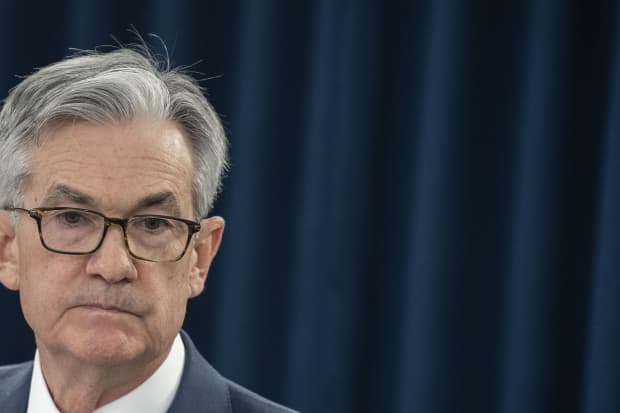This post was originally published on this site

(Federal Reserve Chairman Jerome Powell
Agence France-Presse/Getty Images
The Federal Reserve has cranked the monetary taps wide open and signaled that this policy will continue for years. Although not a substitute for fiscal stimulus, the economic boost provided by these expansionary policies is badly needed in the face of the coronavirus crisis.
At the same time, this looser monetary policy is a dangerous combination when paired with the aggressive weakening of financial regulation by Jerome Powell’s Fed over the past three years. Given that loose monetary policy invariably fuels Wall Street excess, the Fed will have to reverse its deregulatory course.
Lower interest rates TMUBMUSD10Y, 0.869% encourage economic activity by lowering the cost for families to finance homeownership or purchase cars, and for Main Street businesses to invest.
Inflating bubbles
But they also lower rates for Wall Street, and do so even more effectively, since major banks have direct access to Fed financing as primary dealers. Wall Street uses cheap credit as the high-octane fuel for speculation. As we saw before 2008, these techniques redistribute wealth upward and endanger the economy by inflating bubbles in asset values and encouraging predatory lending.
“ This looser monetary policy is a dangerous combination when paired with the aggressive weakening of financial regulation by Jerome Powell’s Fed over the past three years. ”
After 2008, an extended period of low interest rates triggered a huge boom in corporate buyouts, as private-equity tycoons used cheap credit to engage in an unprecedented wave of acquisitions. It also fueled record levels of share buybacks, as companies borrowed cheaply to repurchase shares so insiders could be rewarded by inflated stock prices.
We are still paying the price for this wave of corporate borrowing. Excess debt burdens could worsen an already severe recession, while the concentration of corporate power in private-equity amplifies inequality.
Today, policy choices that are structurally tilted toward assisting asset markets have already helped to produce the kind of recovery we saw after 2008, a K-shaped recovery, in which the sky is the limit for the investor class but others are left behind. Wealthy individuals with significant holdings of financial assets have done extraordinarily well, with the wealth of billionaires growing by some 30% during the first six months of the pandemic, even as half of lower-income American households saw a job loss. Lower-income households and black and Latino communities were economically devastated.
The Fed balance sheet, a measure of the additional funds it has added to the economy by buying securities, has almost doubled over the pastyear, adding $3.5 trillion. That’s well over twice the $1.3 trillion the Fed flooded the markets with to respond to the financial crisis in the last quarter of 2008. And the Fed committed to a permanent shift toward a greater emphasis on full employment in its pathbreaking August statement.
Persistently low interest rates
So, we face a very extended period of near-zero short-term interest rates 30-DAY FEDERAL FUNDS, combined with unconventional monetary policy that aggressively uses balance-sheet expansion to lower longer-term interest rates.
For example, in a recent paper, Fed economist Michael Kiley estimates that, beyond zero short-term interest rates, the Fed will have to buy a total of $6.5 trillion in securities to reach desired levels of economic stimulus in the face of the pandemic-induced recession. This analysis implies an additional $3 trillion in quantitative easing expansion will be added to the Fed’s record balance sheet.
But this flood of money could fuel excessive financial speculation and Wall Street manipulation of the economy, making restrictions on what big financial institutions can do with cheap money absolutely critical. On this front, the Powell Fed has consistently failed, and failed badly.
The Fed has systematically weakened critical restrictions against excessive borrowing by big banks. It has undermined the stress-test process, which is designed to ensure that banks don’t risk a financial collapse by taking on excessive debt. As a result, bank leverage has increased steadily throughout Powell’s tenure, and we enter this recession with big-bank debt burdens at their highest level since 2011. The Fed and other agencies have also gutted Volcker Rule protections against risky speculation and capital markets activities by big banks.
When it comes to private equity and hedge funds, as well as other nonbank investors, the situation is even worse. There are few if any real controls on the ability of those entities to use cheap credit to fuel leveraged speculation, predatory acquisitions of companies, or other harmful financial engineering. The Fed can’t solve this problem alone, but it must lead a joint effort by financial regulators so that permissive monetary policy doesn’t backfire.
When President-elect Joe Biden takes office on Jan. 20, his administration will face an ongoing public health crisis and high unemployment rates that demand immediate attention. But it cannot overlook the urgent need to strengthen financial regulations. A failure to do so could lead to disaster in today’s easy-money environment. We need Fed leadership that will fundamentally change course.
Marcus Stanley is the policy director at Americans for Financial Reform, a coalition of over 200 consumer advocates, labor unions, faith groups and community activists dedicated to building a strong, stable, and ethical financial system.
Mark Hulbert: You shouldn’t believe all this talk about a stock-market bubble about to burst — here’s why
It is time to levy a one-time pandemic wealth tax on billionaires’ windfall gains

